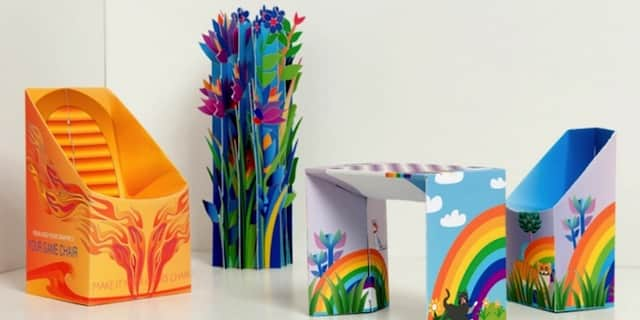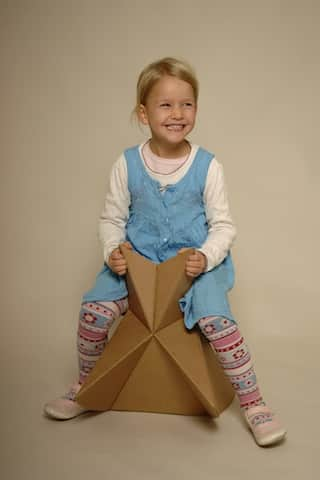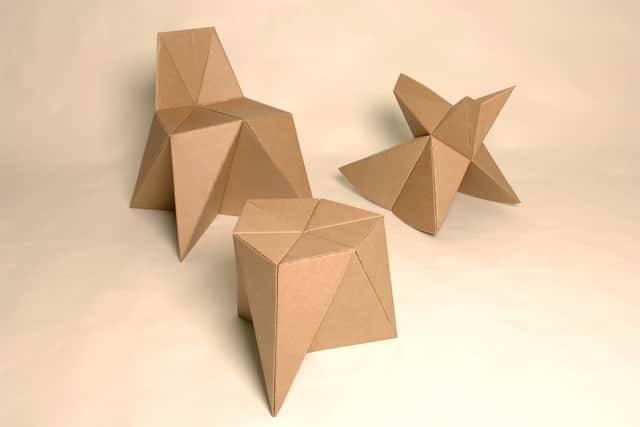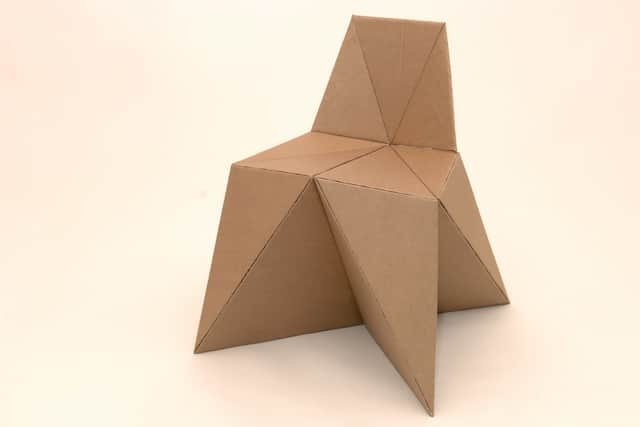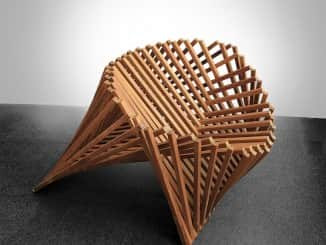A new concept in printed paper furniture for exhibition stand design, event organizers is becoming more and more popular while do-it-yourself cardboard furniture for kids also expand its market share.
High quality, strong, eco-friendly, lightweight micro flute board are supplied as tagged in die cut blanks for large format flatbed printers, to personalize with the clients own graphics. They are flat packed for quick and easy assembly on site and benefits include;
On-demand fast production.
Instant low cost re-branding.
Easy and quick assembly.
Minimal transportation and storage costs.
Unique advertising possibilities.
Re-usable.
The concept of paper furniture and its technology has been developed over the past 50 years by David Bartlett Designs, from the first paper chair produced in 1966 up to a range of paper products produced from the same 2mm thick solid wet foods packaging board. The furniture pieces are supplied as complete die cut and creased sheet blanks held firmly into the sheet ready for printing to keep the costs down. These blanks must be ordered in minimums of 10 assorted items, delivered on paper pallets together with all additional material for assembly.
Each individual item is supplied with a poly bag to keep the furniture clean and protected in transit and storage after printing. This is the most innovative cost effective and professional looking solution for any exibitor or event organizer with or without limited budget.
Another great sample for this type of furniture is called foldschool. It’s a collection of do-it-yourself cardboard furniture for kids. Patterns and a manual can be downloaded easily from the Internet for free.
As is generally known contemporary «design furniture» is expensive. High retail prices are caused mainly by the numerous levels in the wholesale trade and by the costly production procedures in the furniture industry – also because of protection against reproduction. However the history of design has proved that simplicity and elegance can be combined. That’s where foldschool intervenes. One of the goals is to return design to one of its core aims: creating an aesthetic and functional product at a reasonable price through a smart production process and through appropriate dealings with resources. As a countermovement to mass culture that is run by superficiality the mindset of foldschool is to put product and consumer in a personal relationship by understanding craftsmanship as a direct approach to design.
The concept of foldschool is based on sustainability playing out the qualities of a recycled material: folding a flat piece of cardboard according to ergonomic and formal considerations enhances its substandard value generating a spatial structure. Cardboard is a highly suitable material for kids furniture: it is lightweight, it has soft and warm properties and the kids can paint on it. Once it has served its time it can be disposed of with a clear conscience.
Each fragment of the pattern can be printed out on DIN A4/US letter or on DIN A3/Tabloid. Therefore the pattern charts can be manufactured everywhere. The assembly of the furniture requires only easily available tools and devices: cutter, ruler, folding tool, cutting mat, spray adhesive, needle, glue and masking tape. The printed fragments of the pattern are fitted together and fixed on a sheet of cardboard with spray adhesive. After this cut along the outlines of the pattern and press the edge of a ruler into the cardboard in order to have the folds at the right place. If one sticks together the matching lugs, the unrolling will turn into a spatial element. Each design consists of several elements, which glued together create a completed piece of furniture with no open edges: it turns out to have a surprising spatial virtue. The selected folding and gluing technique has originated a collection consisting of a stool, a chair and a rocker. All of them are ergonomically shaped due to the sculptured surface.

